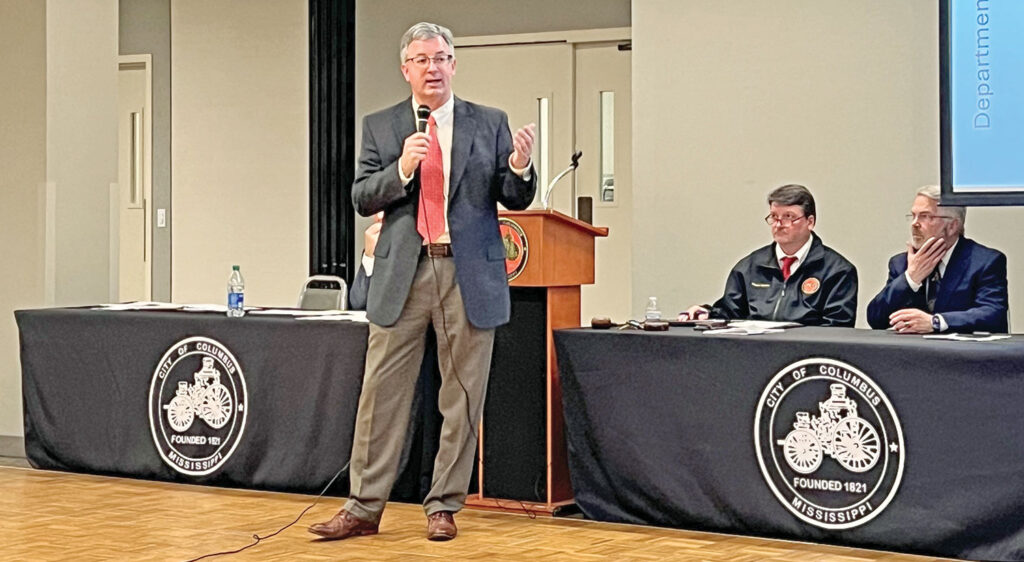Editor’s note: Do you want answers to questions about the Golden Triangle? Each week, Dispatch reporters set out to explain or update a timely, practical issue. Email your question to [email protected].
Last week, the Columbus City Council voted 4-2 to file an ordinance annexing two areas located south and east of the city.
The first of the two areas that would be annexed borders Ward 2 and Ward 3 and is bounded by Highway 82 in the north, Armstrong Road in the east, Lehmberg Road to the west and Deerfield Drive to the south.
The second area, adjacent to Ward 1 and Ward 2, is bounded by South Lehmberg Road to the east, the area adjacent to Scott Drive to the south, Hargrove Road to the west and Vernon Branch Creek to the north.
Once the city’s ordinance is filed with Lowndes County Chancery Court, public notice must be given in the city and in the two affected areas.
There will be a 30-day waiting period before a public hearing is held where proponents and opponents of the annexation can be heard. Then, the judge will set a date for a bench trial in which the city must prove the annexation is reasonable.
If the annexation goes through, what services will the city provide the newly absorbed areas? What happens if county entities are already providing those services?
Services and improvements
Chris Watson, a consultant with Oxford-based urban planners Bridge and Watson, conducted an annexation study for the city that examines aspects of what the annexation would entail such as service provision and legal considerations.
Watson told The Dispatch the city is required to provide the full range of municipal services to the annexed areas. These services would include fire and rescue, police protection and garbage collection.
“Everything that the city provides will be available to the people and property owners that are annexed unless it’s simply not legal for the city to deliver a service or if it’s not economically feasible to deliver,” he said. “(The city) has to make a determination as to whether or not it is economically feasible and legally permissible to deliver utility services into this area.”
Which entity provides utility services, like electricity and water, falls under the legally permissible part. Utility providers hold what’s called a certificate of public convenience and necessity, meaning if the provider has already established service in an area, it isn’t legally permissible for another provider to sell utilities in the same area.
“If an area has power from 4-County Electric Power Association, it doesn’t make any sense to go out and disconnect everyone from 4-County and connect them to Columbus Light and Water. Power is power,” Watson said. “It would be terribly inefficient to disconnect one system and reconnect to another.”
In other words, the annexation would not affect the utilities and residents would still receive services from their existing provider.
While most of the homes within the annexed areas are connected to sewer service, the city doesn’t have any obligation to extend those services to homes and structures that are not connected after annexing.
“This is a situation where most homes are served, (and) some homes are not served,” Watson said. “Depending on the distribution and the cost to extend sewer service to those that are not served, Columbus has got to make a decision as to whether or not its economically feasible to make those sewer extensions.”
If the city determined it would be economically feasible to extend those services, it would be obligated to do so post-annexation. But the city is not obligated to extend sewer services if it was determined not to be feasible, Watson said.
School districts
As for school districts, the lines won’t change in the case of annexation. So county students living in annexed areas would continue to attend their current schools. In the case that students in either of the two areas wants to transfer to city schools, that decision boils down to the school district’s transfer policies. Annexation will not affect school districts in any way whatsoever, Watson said.
McRae is a general assignment and education reporter for The Dispatch.
You can help your community
Quality, in-depth journalism is essential to a healthy community. The Dispatch brings you the most complete reporting and insightful commentary in the Golden Triangle, but we need your help to continue our efforts. In the past week, our reporters have posted 43 articles to cdispatch.com. Please consider subscribing to our website for only $2.30 per week to help support local journalism and our community.







